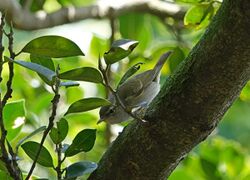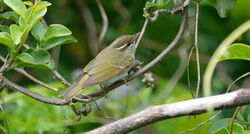Biology:Ijima's leaf warbler
| Ijima's leaf warbler | |
|---|---|

| |
| Warbler in Taiwan (April 2021) | |
| Scientific classification | |
| Domain: | Eukaryota |
| Kingdom: | Animalia |
| Phylum: | Chordata |
| Class: | Aves |
| Order: | Passeriformes |
| Family: | Phylloscopidae |
| Genus: | Phylloscopus |
| Species: | P. ijimae
|
| Binomial name | |
| Phylloscopus ijimae (Stejneger, 1892)
| |
| Synonyms | |
|
Acanthopneuste ijimae (protonym)[2] | |
Ijima's leaf warbler (Phylloscopus ijimae) (also known as Izu leaf warbler, Ijima's willow warbler or Ijima's warbler) is a species of Old World warbler in the family Phylloscopidae. The species is native to Japan , where it has been designated a Natural Monument under the 1950 Law for the Protection of Cultural Properties,[6] with records also from Taiwan and the Philippines.[1]
Taxonomy

Ijima's leaf warbler is a monotypic species first described by Leonhard Stejneger in 1892, based on three specimens collected in the spring of 1887 by Namie Motokichi (ja) on Miyake-jima and Nii-jima, in the Izu Islands of Tokyo.[2] Initially given the scientific name Acanthopneuste ijimae by Stejneger,[7] Momiyama Tokutarō (fi) followed suit in a 1923 paper on the birds of Izu Ōshima.[8]:206 In a 1926 paper on a collection of birds from the Ryūkyū Islands, Kuroda Nagamichi treated the warbler instead as a subspecies of the western crowned warbler, as Acanthopneuste occipitalis ijimae,[3]:85 Yamashina Yoshimaro following suit in 1935.[9]:431 In 1938, Claud Ticehurst treated the warbler as a "race" of the eastern crowned warbler (Phylloscopus coronatus),[5][10] as did Allan Robert Phillips in 1947, based on three specimens from the southern part of Okinawa Island, the combination being Phylloscopus coronatus ijimae.[4] In 1953, citing differences in songs and nesting behaviours, Oliver L. Austin and Kuroda Nagahisa elevated the warbler to specific rank, with the binomial Phylloscopus ijimae,[11]:543 a treatment followed the next year by Charles Vaurie[12]:22 Kenneth Williamson treated the warbler as a subspecies of the pale-legged leaf warbler, under the combination Phylloscopus tenellipes ijimae;[5] however, due to differences in its vocalizations, nesting preferences, and DNA,[7] the warbler has again been elevated to species rank, as Phylloscopus ijimae.[13] The specific name honours Ijima Isao, for his contributions to Japanese ornithology.[2][14]
Description

Ijima's leaf warbler is a small passerine with a total length of 11.5 cm (4.5 in) and weight of around 10 g (0.35 oz).[16] The crown and nape are a greenish-grey, upperparts a bright olive green, flanks greyish, and underparts white.[7] It has a long white or buffish-white supercilium, blackish eyestripe, and dark brown iris.[7] The beak is relatively long and "broad-based", the upper mandible dark brown, the lower yellowish, and the legs and feet a pinkish brown.[1][7]
The warbler is similar in appearance to the eastern crowned warbler (Phylloscopus coronatus), from which it may be distinguished visually by the absence of a central stripe on its crown and by its paler yellow undertail coverts.[7][15] Its song and calls, which include "swss, swss, swss", "swee-swee-swee-swee-swee", "shwee-it, shweet, shweet, shweet", and a soft "se-chui, se-chui, se-chui" and "phi-phi-phi",[7] also differ from those of the eastern crowned warbler.[17]
Distribution and habitat
Ijima's leaf warbler breeds in the summer in the Izu Islands, from Izu Ōshima to Aogashima, and also on Nakanoshima in the Tokara Islands.[16][18] In the spring and autumn, there are records of its presence from Honshū (Shizuoka, Aichi, and Wakayama prefectures), Mizunoko-jima, Tanegashima, Yakushima, and Okinawa Island and the Yaeyama Islands in the Ryūkyūs.[16][18] Its wintering grounds are poorly understood; a small number may overwinter in the Izu Islands (Miyake-jima and Hachijō-jima[17]) and Ryūkyū Islands, while there are also records from Taiwan and Luzon in the northern Philippines.[15][18] It inhabits the "lowland deciduous and mixed subtropical evergreen forest" and laurel forest, including the forest edge, stands of alder (Alnus) and bamboo, and shrubland.[15][18]
Ecology
Insects form the principal component of its diet — when written in kanji (飯島虫喰),[17] the warbler's Japanese name reads as "Ijima's insect-eater" — which also includes seeds.[18] For these it forages, singly or in small groups (sometimes including other species, in particular long-tailed tits (Aegithalos caudatus)), on lower branches, in the forest canopy, and on the ground, and it may also take prey in mid-air.[18][19]
The breeding season is from April to June or July.[16][18] Nests are built some 0.5–2 m (1 ft 8 in–6 ft 7 in) from the ground,[7] on broad-leaved trees and in bamboo (this nesting behaviour differs from that of the eastern crowned warbler, which nests on the ground and in earthen banks).[18] The clutch size ranges from two to four eggs, with three or four the most common.[18]
Conservation
The declining population, thought to total fewer than 10,000 individuals,[1] is threatened by habitat loss and fragmentation.[7][15] In addition, the availability of prey may be impacted by the use of pesticides.[18] The species was badly affected by the eruption of Miyake-jima in 2000.[18]
With an estimated 3% of the global population, Phylloscopus ijimae (Chinese: 飯島柳鶯) is included on the 2016 Red List of Birds of Taiwan with the status "vulnerable".[20]:38 (The species is also included on the 2016 Red List of China's Vertebrates (with the vernacular name 日本冕柳莺), with the status "near threatened".[21]:523) In the Philippines, the species is included on the National List of Threatened Fauna, as a migrant bird on Luzon, with the status "vulnerable".[22] On the 2020 Japanese Ministry of the Environment Red List, Phylloscopus ijimae (Japanese: イイジマムシクイ) has the status "vulnerable",[23] as it had done also on the 1998 and 2007 editions.[16]
See also
- List of birds of Japan
- List of Red Lists
References
- ↑ 1.0 1.1 1.2 1.3 BirdLife International (2016). "Phylloscopus ijimae". IUCN Red List of Threatened Species 2016: e.T22715353A94449596. doi:10.2305/IUCN.UK.2016-3.RLTS.T22715353A94449596.en. https://www.iucnredlist.org/species/22715353/94449596. Retrieved 3 June 2022.
- ↑ 2.0 2.1 2.2 2.3 Stejneger, L. (1892). "Two additions to the Japanese avifauna, including description of a new species". Proceedings of the United States National Museum 15 (906): 371–373. https://www.biodiversitylibrary.org/page/15737339.
- ↑ 3.0 3.1 Kuroda Nagamichi (1926). "On a small collection of Birdss from the Riu Kiu Islands" (in en, ja). Japanese Journal of Ornithology 5 (22): 79–95. doi:10.3838/jjo1915.5.22_79.
- ↑ 4.0 4.1 Phillips, A.R. (1947). "Notes on Phylloscopus coronatus ijimae". The Auk 64 (1): 127–128. doi:10.2307/4080070.
- ↑ 5.0 5.1 5.2 Williamson, K. (1976). Identification for Ringers 2: The Genus Phylloscopus. British Trust for Ornithology. p. 44.
- ↑ "Error: no
|title=specified when using {{Cite web}}" (in ja). Agency for Cultural Affairs. https://kunishitei.bunka.go.jp/heritage/detail/401/3190. - ↑ 7.0 7.1 7.2 7.3 7.4 7.5 7.6 7.7 7.8 Handbook of the Birds of the World. 11: Old Worlf Flycatchers to Old World Warblers. Barcelona: Lynx Edicions. 2006. pp. 667–668. ISBN 84-96553-06-X.
- ↑ Momiyama Tokutarō (1923). (in ja)Japanese Journal of Ornithology 3 (14): 196–213. doi:10.3838/jjo.3.14_196.
- ↑ Yamashina Yoshimaro (1935). "On Acanthopneuste occipitalis ijimae and Locustella ochotensis pleskei" (in ja). Japanese Journal of Ornithology 8 (40): 431–439. doi:10.3838/jjo1915.8.40_431.
- ↑ Ticehurst, C.B. (1938). A Systematic Review of the Genus Phylloscopus. London: Trustees of the British Museum. p. 162.
- ↑ Austin, O.L.; Kuroda Nagahisa (1953). "The Birds of Japan: their status and distribution". Bulletin of the Museum of Comparative Zoology 109 (4): 277–637. https://www.biodiversitylibrary.org/page/3886127.
- ↑ Vaurie, C. (1954). "Systematic Notes on Palearctic Birds. No. 9. Sylviinae: the genus Phylloscopus". American Museum Novitates (1685): 1–23.
- ↑ Gill, F.; Donsker, D.; Rasmussen, P., eds (2022). "IOC World Bird List v12.1: Bushtits, leaf warblers, reed warblers". https://www.worldbirdnames.org/new/bow/bushtits/.
- ↑ Beolens, B.; Watkins, M.; Grayson, M. (2014). The Eponym Dictionary of Birds. Bloomsbury. pp. 274–275. ISBN 978-1-4729-0573-4.
- ↑ 15.0 15.1 15.2 15.3 15.4 "Error: no
|title=specified when using {{Cite web}}" (in ja). Tokyo Metropolitan Government. https://tokyo-rdb.metro.tokyo.lg.jp/index.php. - ↑ 16.0 16.1 16.2 16.3 16.4 Ministry of the Environment, ed (2014) (in ja). Gyōsei Corporation. pp. 218–219. ISBN 978-4-324-09896-7.
- ↑ 17.0 17.1 17.2 Kabaya Tsuruhiko; Matsuda Michio 松田道生 (2001) (in ja). Tokyo: Shogakukan. p. 294. ISBN 4-09-480073-5.
- ↑ 18.00 18.01 18.02 18.03 18.04 18.05 18.06 18.07 18.08 18.09 18.10 Collar, N.J., ed (2001). Threatened Birds of Asia: The BirdLife International Red Data Book. B. BirdLife International. pp. 2170–2175. ISBN 0-946888-43-4. http://datazone.birdlife.org/userfiles/file/Species/AsRDBPDFs/species/phylijim.pdf.
- ↑ Clement, P. (2006). "Ijima's Leaf Warbler Phylloscopus ijimae". Cornell University. https://birdsoftheworld.org/bow/species/ijlwar1/cur/introduction?login.
- ↑ Lin, R.-S.; Lu, Y.-J.; Yang, C.-H.; Tseng, T.-J.; Ko, C.-J.; Chen, W.-J. (2016) (in zh, en). Endemic Species Research Institute. ISBN 978-986-05-1406-3. https://www.tesri.gov.tw/A6_2.
- ↑ Zhigang Jiang et al. (2016). (in zh, en)Biodiversity Science 24 (5): 500–551. doi:10.17520/biods.2016076. https://www.researchgate.net/publication/304016077.
- ↑ "National List of Threatened Fauna". Biodiversity Management Bureau. https://bmb.gov.ph/index.php/facts-and-figures-wild/national-list-of-threatened-fauna.
- ↑ "Error: no
|title=specified when using {{Cite web}}" (in ja). Ministry of the Environment. 27 March 2020. https://ikilog.biodic.go.jp/rdbdata/files/redlist2020/redlist2020_tyorui.csv.
External links
Wikidata ☰ Q1590370 entry
 |


